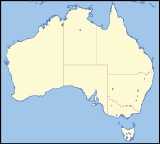
Kalbarri National Park
Encyclopedia
Kalbarri National Park is located 485 kilometres (301 mi) north of Perth
. The major geographical features of the park include the Murchison River gorge which runs for nearly 80 kilometres on the lower reaches of the Murchison River
. Spectacular coastal cliffs are located on the coast near the mouth of the Murchison River and the town of Kalbarri
.
and the Murchison hammer orchid.
The small-petalled Beyeria
or short-petalled Beyeria, which was once considered extinct, was re-discovered in the park in 1994. The population in the park is one of only three known populations.
Available activities in the park include horse riding, hiking, swimming, canoeing, and rafting. From Kalbarri there are scenic cruises along the Murchison River.
s, thorny devil
s, emu
s, osprey
s, wedge-tailed eagle
s and pelican
s. The threatened tammar wallaby
used to be found here, but has not been observed in the area lately.
Aprroximately 170 species of birds inhabit the park.
Inland part, along the Murchison River Gorge:
Perth, Western Australia
Perth is the capital and largest city of the Australian state of Western Australia and the fourth most populous city in Australia. The Perth metropolitan area has an estimated population of almost 1,700,000....
. The major geographical features of the park include the Murchison River gorge which runs for nearly 80 kilometres on the lower reaches of the Murchison River
Murchison River (Western Australia)
The Murchison River is the second longest river in Western Australia. It flows for about from the southern edge of the Robinson Ranges to the Indian Ocean at Kalbarri. It has a mean annual flow of about 200 million cubic metres.-Course:...
. Spectacular coastal cliffs are located on the coast near the mouth of the Murchison River and the town of Kalbarri
Kalbarri, Western Australia
Kalbarri is a coastal town in the Mid West region located 592 km north of Perth, Western Australia. The town is found at the mouth of the Murchison River and has an elevation of...
.
Geography
The area is also famed for the diversity and extent of wildflowers during winter months. Twenty-one plant species are found only in the coastal cliff tops and gorge country predominantly in the National Park. One of the best known local plants is the Kalbarri catspaw, a small yellow or red plant that is usually seen on recently burnt country from August to September. Several orchids can only be seen in and near the park, including the Kalbarri spider orchidSpider orchid
Spider orchid typically refers to the orchid genus Caladenia as a whole.It may also mean one of the following:* Several Corybas species, including** Corybas macranthus** Corybas trilobus...
and the Murchison hammer orchid.
The small-petalled Beyeria
Beyeria
Beyeria is a genus of shrubs and small trees in the family Euphorbiaceae. The genus is endemic to Australia.Species include:*Beyeria brevifolia Benth.*Beyeria calycina Airy Shaw *Beyeria cinerea Benth....
or short-petalled Beyeria, which was once considered extinct, was re-discovered in the park in 1994. The population in the park is one of only three known populations.
Climate
Summer temperatures frequently exceed 40 degrees Celsius in the inland part of the park. During this time the temperature in the upper section of the park can often be more than 10 degrees Celsius higher than in the town of Kalbarri.Available activities in the park include horse riding, hiking, swimming, canoeing, and rafting. From Kalbarri there are scenic cruises along the Murchison River.
Fauna
Kalbarri has many birds and animals, the latter mainly nocturnal mammals. Species present are western grey kangarooWestern Grey Kangaroo
The Western Grey Kangaroo is a large and very common kangaroo or macropod, found across almost the entire southern part of Australia, from just south of Shark Bay to coastal South Australia, western Victoria, and the entire Murray-Darling Basin in New South Wales and Queensland...
s, thorny devil
Thorny Devil
Thorny Devil is an Australian lizard. It is also known as the Thorny Dragon, Mountain Devil, Thorny Lizard, or the Moloch and is the sole species of genus Moloch....
s, emu
Emu
The Emu Dromaius novaehollandiae) is the largest bird native to Australia and the only extant member of the genus Dromaius. It is the second-largest extant bird in the world by height, after its ratite relative, the ostrich. There are three subspecies of Emus in Australia...
s, osprey
Osprey
The Osprey , sometimes known as the sea hawk or fish eagle, is a diurnal, fish-eating bird of prey. It is a large raptor, reaching more than in length and across the wings...
s, wedge-tailed eagle
Wedge-tailed Eagle
The Wedge-tailed Eagle , sometimes known as the Eaglehawk in its native range, is the largest bird of prey in Australia, but it is also found in southern New Guinea. It has long, fairly broad wings, fully feathered legs, and an unmistakable wedge-shaped tail...
s and pelican
Pelican
A pelican, derived from the Greek word πελεκυς pelekys is a large water bird with a large throat pouch, belonging to the bird family Pelecanidae....
s. The threatened tammar wallaby
Tammar Wallaby
The Tammar Wallaby , also known as the Dama Wallaby or Darma Wallaby, is a small member of the kangaroo family and is the model species for research on kangaroos and marsupials. It is found on offshore islands on the South Australian and Western Australian coast...
used to be found here, but has not been observed in the area lately.
Aprroximately 170 species of birds inhabit the park.
Highlights
Coastal part, starting from the town of Kalbarri and moving south:- Red Bluff
- Mushroom Rock
- Rainbow Alley
- Pot Alley
- Eagle Gorge
- Shellhouse and Grandstand
- Island Rock
- Natural Bridge
Inland part, along the Murchison River Gorge:
- The Loop
- Z Bend
- Hawks Head
- Ross Graham Lookout

